#loosely based on dresses from the 1890s
Text
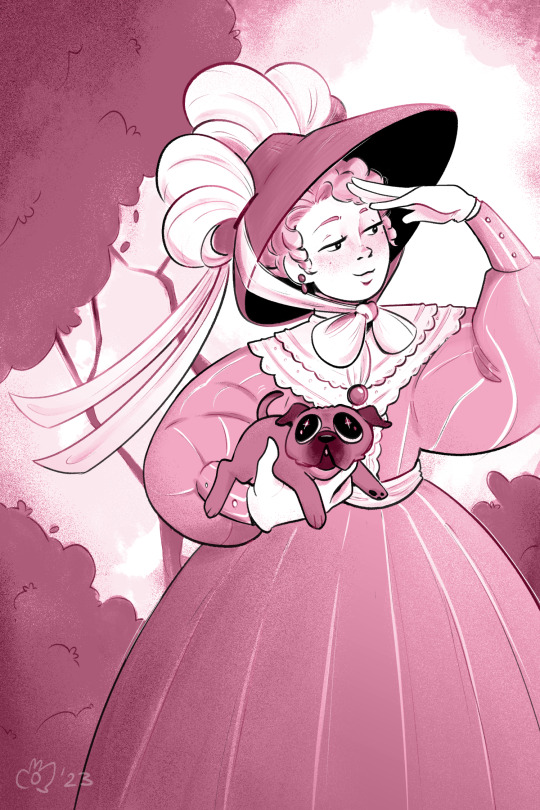
two ladies, pretty in pink on a breezy morning promenade
#oc art#charlotte and lottie#reasonably accurate historical fashion#loosely based on dresses from the 1890s#if youre into that kind of thing#period romance#not that i've written it yet but shes gonna have one eventually
90 notes
·
View notes
Text
Late Victorian British Fun (and not-so-fun) Facts
I thought others might be interested in my list of little things I've learned while researching the 1890s for my fics. This is by no means a list of things you should do when writing! Even I don't follow absolutely every single thing—I like to think wizarding society deviated quite a bit from muggle society, after all. If you wanna use this list as a reference, go ahead, but you should write whatever makes you happy. This is just for fun, and I'll probably end up writing down more stuff as I remember it—this is all just the stuff I could think of from the top of my head. :)
Basics
The Victorian Era was from 1837 to 1901. The era before was called the Regency Era (think Jane Austen) and the era after was the Edwardian Era (think Downton Abbey).
Love and Marriage
Even though the marriage age was lowered significantly in 1823, most girls still got married between ages 18 and 23.
The social season refers to the summer months from May to August in which the middle and upper classes left their country homes and stayed in London to attend social events, following the royal family. The main purpose was finding someone to marry.
Courtship, the part of a relationship that was most like dating today, only lasted a few months before progressing to being engaged. But it was common for engagement to last much longer. Dating as we know it today wasn't really a thing until after 1900.
Courtship "dates" that weren't in public often consisted of dinner at the woman's house with her parents (private time between the couple was sometimes afforded after dinners).
There was a paradigm shift in attitudes towards marriage; marrying for love became much more common in this era. But marriages were still pragmatic, too! Marriages based purely on love while ignoring the economic and practical aspects were scandalous.
Queen Victoria popularized white wedding dresses as we know them today.
It wasn't until the late Victorian Era that evening weddings became acceptable.
Snakes were a popular motif for engagement rings in the Victorian Era.
Pregnancy and Children
Victorian women were expected to hide all signs of their pregnancy, as it would imply participation in the act required for pregnancy (yeah, lol).
Husbands weren't allowed to be around for the actual act of childbirth, and it was advised he only stay around for 5 minutes afterward.
Anesthesia was first administered in the mid-1800s.
Fathers were often very involved in their children's lives, contrary to popular opinion.
Teenagers haven't changed much since the Victorian Era—our MCs weren't the only troublemakers. :)
Clothing, Personal Care and Fashion
Eyebrows came in all shapes and sizes; no one style appears to have been particularly coveted. The only exception was an aversion to unibrows.
Natural beauty was the name of the Victorian game. As such, makeup was very un-virtuous and was reserved for prostitutes and actors.
That doesn't mean people didn't use any products, however! Salves for the lips, as well as powders and rouges, started becoming popular towards the end of the era.
Perfumes and colognes were kept subtle, but floral scents were very popular amongst both men and women. Again, emphasizing the natural state of the body was seen as very virtuous.
Shapewear was just as popular back then as it is today. Adding or taking away layers of women's undergarments depended on the effect one wanted to have.
Men's undergarments were much simpler, usually consisting of cotton drawers and a long-sleeved undershirt.
Shorter skirts were appropriate for young girls, but as a girl got older, her skirts generally got longer.
School was still relatively uncommon for girls through the end of the era, but school uniforms for girls generally included aprons to protect their clothes.
Very long hair was desirable for Victorian women and was considered very feminine, but wearing that hair loose was not respectable. Bangs (fringes) weren't very popular.
The 1890s introduced the Gibson Girl look that would carry through the Edwardian Era.
Women wearing trousers was not as uncommon as one might think!
Bathing at least once a day was considered essential, but showering was not yet a thing.
Games, Leisure and Sports
Parlour games were very popular with adults at parties. Charades was an especially prevalent game.
Board games were also very popular for both children and adults.
Football (not American football!) became very popular in the Victorian Era amongst men. Croquet was the game of choice for women.
Cemeteries were popular picnicking spots and were more like sculpture gardens than grim reminders of death.
Food and Cooking
Honestly just go watch English Heritage's Victorian videos for an idea of the recipes and foods that were common back then lol. Mrs. Crocombe is a gem.
Breakfast was often a major event for wealthy Victorian Britons.
Ok that's all I can think of for now. I'm sure there's way more I'm missing. If I can come up with enough, I'll do another post at some point lol. Enjoy!
#victorian era#bonus points if you can recognize the bits I've used in my fics lol#ummmm idk what other tags to use oops#hogwarts legacy#references
326 notes
·
View notes
Text
The non-resplendid Outfit: What poor women wore in the mid to late 1800s, Victorian era

Housemaids, early 1860’s. They are dressed in their best for the photographer, but look at their hands. From Victorian Working Women. They could perhaps have scullury maids, who were a lower ranked of housemaid.

Fig. 1 - Washerwoman and young girl • Mid-1800's

Fig. 2 - From 'Street Life in London', 1877, by John Thomson and Adolphe Smith. "The accompanying photograph represents a second-hand clothes shop in a narrow thoroughfare of St. Giles."
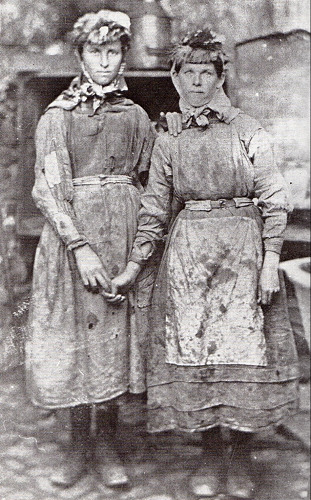
Fig. 3 - These women were referred to as "tip girls". Their job was to unload mine refuse from train cars and on to the "tip" of the mountains of mine waste. Tredegar, Wales, 1865. Photo by W. Clayton from Victorian Working Women
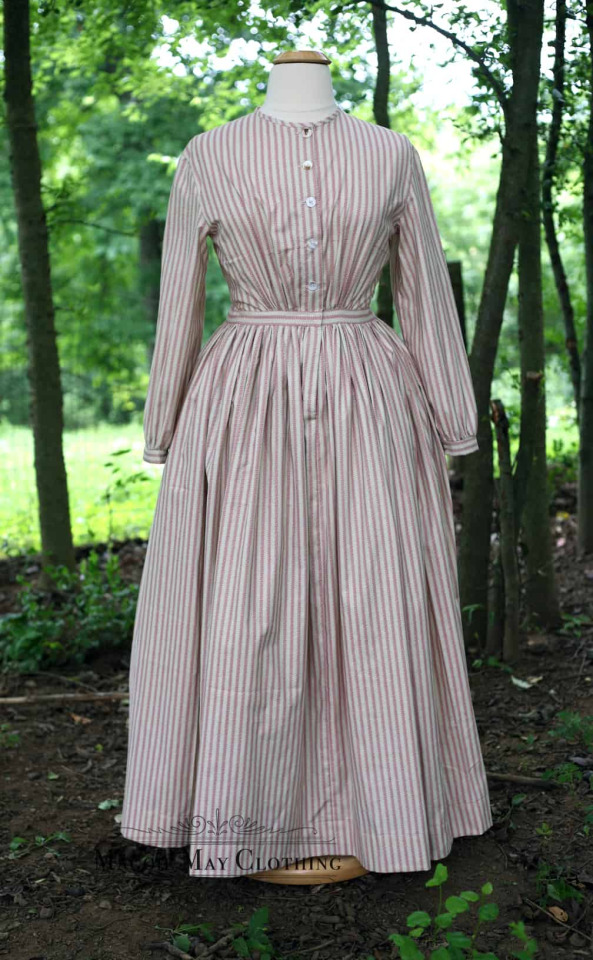
fig. 4 - This dress features a loose fitting, unlined bodice gathered gently under the bust and at the center back. The sleeves are cut moderately to encourage movement and feature a short cuff with button closure. The semi full skirt is gathered into a waistband and attached to the bodice. The skirt is hemmed to the ankle with a single turn hem. The gown closes at the center front with buttons. Shown over over a quilted petticoat and extra full petticoats. Typically worn between 1840 and 1890. This dress is a replica based on research.
Working class women in the Victorian era couldn't afford the latest fashions. They wore simple, practical clothing in a style dependent on their ooccupation. In figure 1, The woman is wearing a simple dress and cape. Her clothing looks clean because she's a washerwoman; her clothing only exposed to water and soap. Her dress is very similar to the one in figure 4.
In figure 2, the women working in the second-hand clothes shop are also performing work that isn't likely to soil their clothing. It's interesting to discover there were such shops. I always assumed poor women of this era made their own clothing.
A job such as handling coal (figure 3) was such dirty work that the clothing worn for it had to be made from thick, rough fabrics and cut loose to facilitate movement. The dirtier and more physically demanding the work, the rougher the clothing.
#fashion history#victorian era#working women#victorian work clothes#1800s women's work#victorian work dress#the resplendent outfit#victorian history#historic photographs#historic clothing#history of workers#women's history
65 notes
·
View notes
Text
Filipiniana inspired by the Entities (the Eye, the Vast, the Dark)
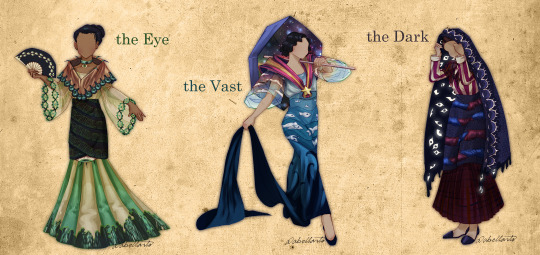



[ID: Three drawings of three modelled Filipinianas against a shared background which looks like aged paper. Each one is labelled a different entity which goes, from left to right, the Eye, the Vast, and the Dark. All the models are faceless. Three close ups follow the main image.
The Eye Filipiniana is an 1890s traje de mestiza featuring a brown panuelo with green embroidered trimming resembling ink pen tips and green strips resembling eyelashes at the opening, a translucent wide-sleeved striped baro in alternating off-white and green with green embroidered eyes for trimming, a dark cyan tapis with rows of books patterned on, and a silky striped saya in alternating yellow and green with an eye where the saya and the tapis meet and embroidery of people walking at the hem. Finished with accessories of a silky green necklace with a hanging realistic eye and a dark blue folding fan with an eye pattern. The model has brown skin and straight black hair up in a bun.
The Vast Filipiniana is a Commonwealth Era Style Baro’t Saya featuring a violet umbrella with a bright galaxy on the inside that the model holds on her shoulder, a magenta panuelo with yellow and orange stripes held together with a bright yellow star-shaped medallion, wide translucent butterfly-sleeved baro with a sunset to sky blue gradient from top to bottom with embroidered white clouds on the sleeves, a tapis with different shades of blue going from a light blue to dark blue top to bottom with embroidered silver fish of differing sizes, and a silky dark-blue-to-deep-blue saya with a long saya de cola with dark silhouettes resembling tentacles creeping up the sides. The model has pale tan skin and wavy hair held up in a loose lower bun.
The Dark Filipiniana is an 1840s Baro’t Saya styled for church-wear featuring a translucent plaid-patterned magenta panuelo, a striped straight-sleeved camisa in alternating dark magenta and off-white, a dark purple tapis embroidered with hands in alternating red and blue gripping each other by the wrist, a plaid-patterned magenta saya, and dark purple sandals. The models holds a dark purple hood over her head, the outside is a dark purple trimmed with white embroidery meant to look like closed eyes, the inside is a dark mass filled with open white eyes in strange positions, the dark mass drips down the edges of the hood, some eyes following. The model has ashy tan skin and combed back brown hair.
./.End ID]
Finally finished it! I’ve wanted to do this for a while but pushed it off until now. The Entities as a couple versions of the Filipiniana. I don’t have plans rn to make the others since I suspect I will soon be busy again. Still, I have some ideas, particularly for the Web. Have a favourite?
My inspiration+info under the cut! :D
1) The Eye
I based the Eye’s Filipiniana off of the “traje de mestiza”, an aristocratic ensemble popular during the 1890s near the end of Spanish colonial rule. It’s also known as the “Maria Clara” gown due to association with the main heroine of Jose Rizal’s novel “Noli me Tangere.”
Ngl I struggled to add more motifs than just “Eye” but I tried to be creative with it. The panuelo (the cloth around the shoulders) is supposed to look like eyelids which is why there are eyelashes. The embroidered trim is supposed to be the tips of ink pens. The trim of her sleeves are eyes. The tapis (the dark cloth around the lower area) features shelves of books. The bottom of the dress is supposed to be the Eye Watching people suffering at the hem. I got extremely lazy though and just got a “people walking” brush from the csp asset store and stamped them on. Didn’t get me the effect I intended but I was too tired to change it.

[ID: A sepia photograph of a woman looking to the left while wearing a traje de mestiza and holding a closed fan. /.End ID]

[ID: An image of the original front cover of Jose Rizal’s Noli Me Tangere manuscript./.End ID]
2) The Vast
The Vast’s Filipiniana I based off of the style popular during the 1930s-1940s Commonwealth Era. Honestly I only chose it because those sleeves are the very definition of vast.
The design has a simple concept but I ended up liking the end result a lot! It’s supposed to be a top to bottom gradient of aspects of the vast. Starting from space, going into sky blue, then ending in the deep abyss of the ocean.
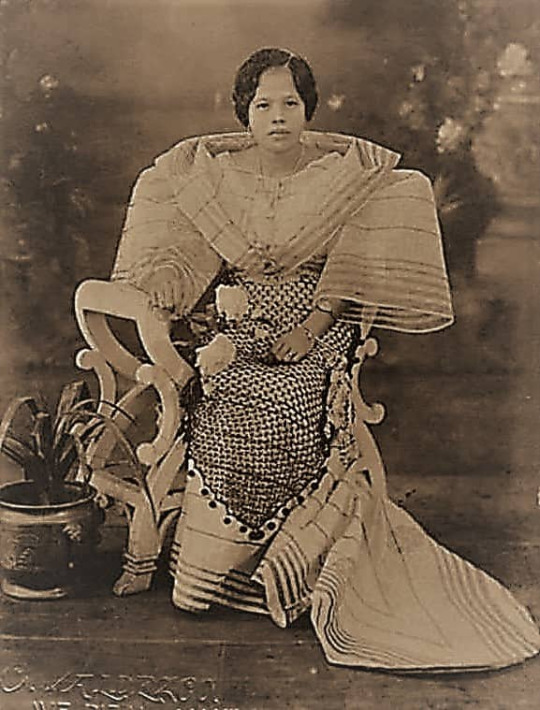
[ID: A sepia photograph of a seated woman wearing a Commonwealth Era Filipiniana. /.End ID]

[ID: A black-and-white photograph of three young women wearing Baro’t Saya in the Commonwealth Era style in a forest setting. All three have their panuelo wrapped around their heads. The girl farthest in the back carries an open umbrella./.End ID]
3) The Dark
Lastly, the Dark’s Filipiniana is based off of 1840s church-wear. I thought I could do something with the hood and the church theme suited the Dark well.
I’ll admit the Dark gave me trouble. Dark is a very vague theme. The hood is the main focus of the dress I think as everything else is pretty standard/I ripped off from the original whoops. The trim is supposed to look like a bunch of closed eyes. The inner hood is a dripping black mass with eyes from who-knows-where. The tapis has a pattern of several hands grasping each other by the wrist because something unknown gripping you from the dark is terrifying. “The blanket never did anything” anyone?
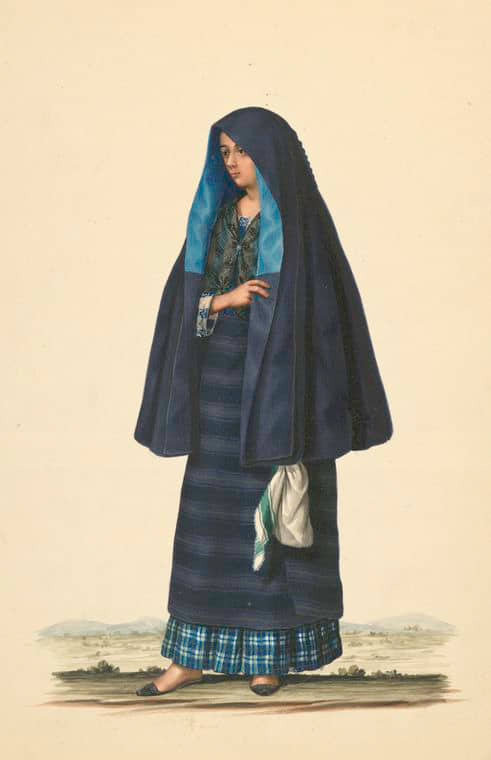
[ID: "A damsel going to early mass," by Justiniano Asuncion, 1841. The painting features a woman looking to the left, wearing darkly coloured 1840s church-wear with a hood, she holds a white cloth in her right hand./.End ID]
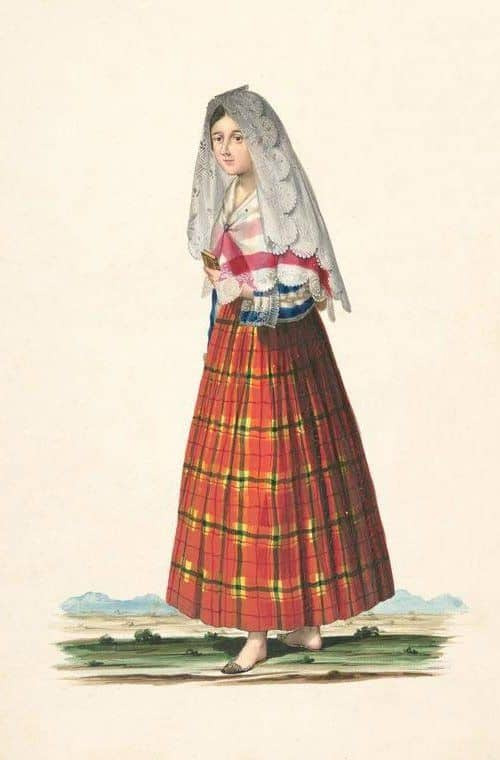
[ID: "A señorita walking to church in the daytime," by Justiniano Asuncion, 1841. The painting features a woman looking to the left, wearing brightly coloured 1840s church-wear with a thin gauzy white hood. She holds a small book, presumably a bible. ./.End ID]
#tma#The Magnus Archives#MagnusPod#MagPod#The Entities#The Eye#The Beholding#The Vast#The Dark#Abellarts#i worked hard on this don't flop/j
627 notes
·
View notes
Text
Overanalyzing Guillermo del Toro's Crimson Peak
Continuing with my very long posts overanalyzing my favourite movies, yesterday I saw del Toro's 2015 Crimson Peak for like the 50th time. Being one of my favourite movies i always talk about how i could make an essay just based on the link between the power of the characters and their hair, and i though 'Welp, Tumblr exists, might as well!' so here it is. SPOILERS AHEAD!!!
For those of you who don't know, Crimson Peak is the name of a movie from 2015 directed and written (i think) by Guillermo del Toro. It's NOT a horror movie, as many people think, but a gothic romance type of movie, with a lot of ambiance and spirits that are more metaphorical than scary. The movie was not very well received because people thought it would be a horror movie due to the trailers focusing too much on the horror aspect of the ghosts, but i find it to be one of the best movies made in the gothic genre. As a gothic writer myself, it really is one of the best examples of the genre there is!
Now, the movie has a lot of gorgeous aesthetic choices that carry a heavy symbolism. Set in the 1890s to the 1900s, the victorian aesthetic of the turn of the century helps the movie have more modern aditions like typewriters and gramophones, which almost helps the story feel more modern since most gothic stories take place in the middle of the nineteenth century, and they feel further and more distant to readers. Many of the choices in clothing also help with one of the biggest symbolisms in it: the moth vs the butterfly. Edith, our protagonist, wears appropriate clothing for the period with big puffy sleeves and golden colours that help us see her as a beautiful butterfly, while Lucille wears clothes from a decade earlier, which help with showing the brothers are struggling with money, but also stucks her in a 1970s dress that almost looks like a pupa, where a dangerous black moth is going to come out of. Lucille is placed as the black moth, dangerous for the butterfly and opressive to herself and others. The costuming in the movie is great, but i want to talk about the colors the movie uses and how they relate to power.
In Edith's home, the main colours used are golds and browns, which help us see she feels powerful and good in her hometown, as shown also by her golden hair. Lucille and Thomas inmediatly look out of place, dressed mostly in black and cool greys, with the exception being Lucille's red dress she wears when she's first introduced, showing us she's dangerous, a walking red flag. Her hair, of course, is a deep raven black. Lucille and Edith both have a power struggle, in this case because of the love the each feel for Thomas, and the only thing that doesn't change in them is their hair colour, since in the climax and fighting scene both of them wear their hair loose while dressed in white, showing their power struggle. Something happens in Allerdale Hall as well: Edith's clothes become darker and less saturated, and her hair becomes loose. Her hair, her power, is becoming less and less as Lucille, still dressed in black for most of this part of the film, has gained power being in her isolated mansion.
While in Edith's town, at the park, Lucille cuts of a butterfly's chrysallis from a tree branch before the butterfly comes out, as she sits on a floor covered in dead butterflies in golden colours. And this is one of my favourite parallels of the movie. In the last moments of the film, before her fight with Edith, while Edith signs her lawyer's documents focibly, Lucille cuts of a lock of her hair. In the victorian era, cutting your hair wasn't very common amongst the higher classes, only being done to people who had passed away as a means of remembering by creating jewels out of their hair. The act of cutting of one of Edith's golden locks is basically Lucille telling her 'I won, you have no power, this is your end, your death', similar to how she cuts of the butterfly from the tree, yet again showing Lucille as a black moth that eats the golden butterfly. But Edith still has her power, with her golden hair long and cascading down her shoulders, and she uses said power to escape and, in the end, manages to kill the black month, turning Lucille into a black vengeful spirit.
This movie is one of the best i've seen in a while and you can see how obssessed i am with it lol. Just like the hair, the costuming and settings of the film as well as things like lighting and use of colour are charged with heavy symbolisms and meanings that you can look into if you're obssessed with it like i am. I highly recommend it if you haven't seen it and you like ghostly romances in creepy haunted mansions.
#film#cinema#guillermo del toro#movies#film review#movie review#review#crimson peak#mia wasikowska#tom hiddleston#gothic#gothic aesthetic#romance#romantic suspense#ghost
19 notes
·
View notes
Photo

gilded! age!
basically i asked myself, if i were to draw harry and mj attending a met gala together, with a gilded age theme, how would i draw them? and the answer is: as above.
harry’s whole deal is based loosely off of “king of the dudes,” Evander Berry Wall, including the thigh high patent boots and the big ol’ (three) jacket(s)... and some mauve because c’mon, aniline purple
MJ’s look is based loosely off of an 1890s wedding dress but changed significantly by the addition of pants and evening gown-style cleavage. ironically the part based most off the dress (aside from the sleeves) is the waist, which is obscured by the pearls... lol oops
the buttons on her boots are definitely like a bunch of (probably fake/costume) jewels rather than normal buttons. glam!
#nadiart#coffee bean gang#mary jane watson#harry osborn#...#met gala#this is not a metsona but you know how it is#fanadiart#rough art#arghdesign#admittedly aniline purple dye predates the gilded age but only by about twenty years#not pictured: johnny storm in an ensemble that is approximately a century off but fabulous nonetheless#that or johnny is literally just dressed as a cowboy and everyone makes fun of him but it's 100% on theme for the late 19th century
88 notes
·
View notes
Text
August 1, 2022
If someone mentions the 1890s I practically froth at the mouth and I blame that exclusively on Bernadette Banner.
It doesn’t help that Absolute History has plenty of documentaries/series based on that era. I binged Victorian House and have found comfort in the Arts and Crafts movement of the late Victorian era. It’s a lovely little series that combines historical documentary, reality television, and competition in a package complete with lovely costuming.
I made butter cookies [edit: my mom says they taste like shortbread which I’ve never had but I’ve been binging Victorian Upstairs Downstairs and Rose used a beautiful mold to form a shortbread she made and now I want one desperately] and by themselves they’re just alright but with strawberry jam??? Impeccable. Eating one I feel like I’ve stepped into one of those cottagecore aesthetic photos. I just need some fresh fruit, a field, a picnic blanket, and a sundress and that could be me. I generally do not trust the oven in my apartment’s kitchen but since my meal plan this semester is going to be minimal I think I might try baking cookies in there every once in a while. I just wish I was faster at cooking you know? It’s another one of those things where I just have to remind myself that practicing it will make me better and that I can’t expect to immediately master cooking or anything for that matter and that it’s okay to have little (or big) fails along the way.
Speaking of things I’m getting better at, I finished the pink dress (it’s okay, and I’m glad I made it, but I need to find an event to wear it to) and immediately began working with the seafoam/robin egg blue cotton/linen. I basically worked on that thing for a whole day and cranked out most of what I’m calling a “double pleat” skirt (ankle length, side pocket opening, white cotton ‘round the interior hem (literally just copying Sondeflor tbh but it’s not like I’m selling it, I just think it’s a cute detail)) which basically gives more flare for each pleat than a normal 3-times-your-waist (this came out to ~4.5 times my waist!) and it’s kind of fantastic and I want to make so many more of these. It went together super quick (and I took my time, basting each pleat by hand) bc it was just rectangles (after I worked out the math) and I mean its main purpose is going to be a Renn Faire piece probably because the single issue with it is that I sewed some of the rectangles together (I had to use piecing bc the fabric wasn’t wide enough) on the selvages since usually the selvages are the most stable parts of the fabric but after I’d finished french seaming pretty much everything I discovered that these selvages were super loosely woven and that this caused a ton of weird warping problems and it’s like not terrible but it is certainly noticeable (and also bc the color isn’t really something I think I’d like to wear daily). BUT despite all that (I mean there’s a small chance that I could fix the warping issue but I’d have to be really careful) I really like it! It’s super voluminous and makes me feel like a fairytale maiden. Oh to be an elf named Elowyn galivanting through a forest devoid of creepy crawlies and wearing an impractically long dress (though I must say I’m glad I went for a two-piece, more mixing and matching that way (once I get to making more pieces, that is)).
The next part of the faire kit is going to be a bodice (made from the princess seam block which I’ve finally finished, I think) which will be made from whatever’s left over from the skirt fabric, flatlined with muslin probably (or maybe linen if I can find some stashed away). Ideally I’ll bind the edges with bias tape and figure out how to bind eyelets by hand, but we’ll see. Maybe I’ll even bone a few seams. I’m considering making a baglined test with some home deco fabric first, we’ll see.
As you can see, now that school is a month away, I’ve entered crunch time on my projects. I still need to prepare substantial handsewing projects.
Today I’m thankful that I might have a TA position for a class I’ve wanted to be a TA in for a year, and I may have the chance to do it twice: this winter and again in the spring. Nothing’s official, but I’m still very very very excited. I’m also thankful that I didn’t get a ticket on campus today (the parking meter didn’t print my receipt and I was quite worried (as I often am) that today would be The Day). I’m also thankful that I actually enjoy the skirt I made!! I’m also thankful for Star Trek: Strange New Worlds. It was a lovely first season and I can’t wait for the second (jailbreak episode, anyone?).
1 note
·
View note
Text
History of Chinese standing collars (part 2: Republican era)
Quick recap: I was debating with myself whether “Mandarin collar” should be a thing because standing collars throughout Chinese history looked different. In part 1 I went through standing collars in the Ming and Qing Dynasties, now I’m going to investigate the Republican era (1912-1949). I numbered the styles in part 1 but they’re only guidelines so you don’t have to remember anything.
*I’m not including Manchu womenswear in this post because they weren’t very significant to collars and there’s a lot I need to verify, so hopefully I’ll make separate posts about it one day.
1910s
Summary of 1910s Han women’s fashion here.
Let’s look at Han women’s fashion first. The 1910s continued the use of collar style 7 from the 1890s and 1900s; this style of collar, often called 元宝领 yuanbaoling, ingot collar, or 马鞍领 ma’anling, saddle collar, after the objects it resembles, was so tall that it reached the cheeks of the wearer and could not be closed in the front at all. It could be trimmed with binding, piping, or commonly in this era, fur or ruffles. It could have either rectangular or round edges. It was closed by one 盘扣 pankou, this fabric braided button, at the base, but it could have more pankous for ornamental purposes. Around this time people began experimenting with stiffening and structure in standing collars; this was a result of Western influence, specifically the standing collars on some Western military uniforms. I don’t think Chinese collars were ever boned like Victorian and Edwardian women’s collars, but a layer of stiff interlining was probably enough to give a collar shape and rigidity. Because of the extraordinary height of collar style 7, it had to be stiffened.
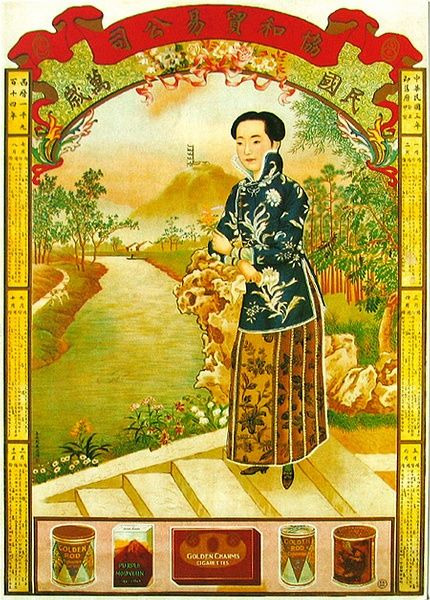
Source here
Calendar painting from 1914. This collar has a rectangular edge and is trimmed with fur.

Source here
Calendar painting from 1915-1916. This collar has a rounded edge and wide binding.
However, this ultra tall collar wasn’t everybody’s cup of tea and normal height collars existed as well, especially in the beginning and end of the decade. A new invention of this era was this tall collar with slightly rounded edges closed by two to three pankou----in some extreme cases four. I believe they were stiffened, but even if they were not, the use of wide, heavyweight binding could give it shape and rigidity. This style probably grew out of collar styles 2 and 3 from 19th century Han women’s collars, but it is going to become very iconic and distinct later in the 30s so let’s label it collar style 8. All Han women’s standing collars before the 1970s were extremely fitted, i.e. they completely hug the wearer’s neck and could sometimes be restrictive to neck movement. The loose fitted collars often seen on modern mass produced cheongsam is not historically accurate.
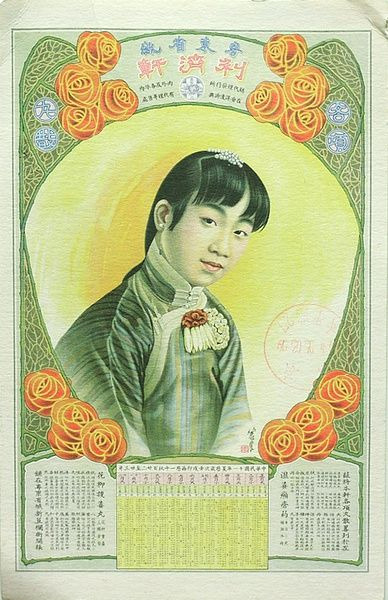
Source here
Calendar painting from 1911 showing collar style 8. It had three pankou, wide double row binding and could be closed at the front.
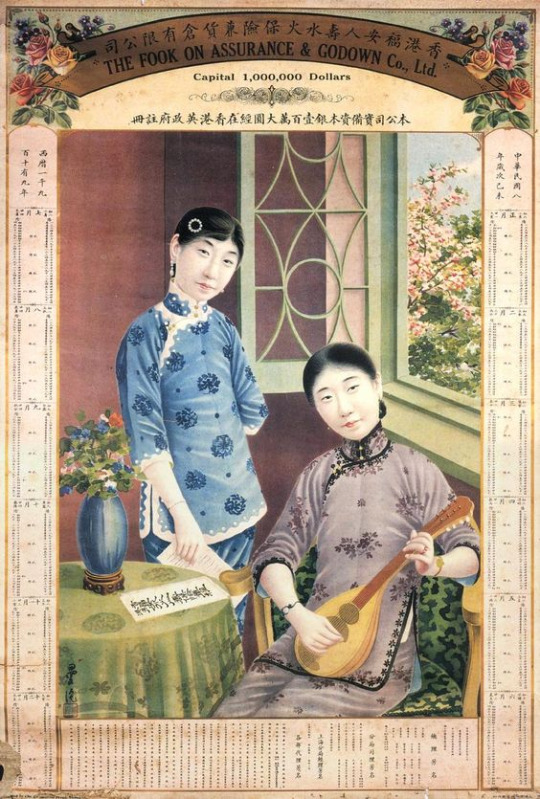
Source here
Calendar painting from 1919 also showing collar style 8. Throughout the 1890s, 1900s, 1910s and early 20s, innovative/Western trims like lace were commonly used instead of plain binding.
Quickly turning our attention to menswear. I’m not a menswear expert so feel free to add info or references. In the 1910s, menswear collars followed a similar development. After looking at more photos from the period, I figured out that in the late 1900s, men’s collars still had rectangular edges and were pretty low. This was also echoed in the formal dress code issued by the republican government in 1912. You can read more about the formal dress code in this article, it’s a great guideline for understanding ceremonial clothing in the republican era.
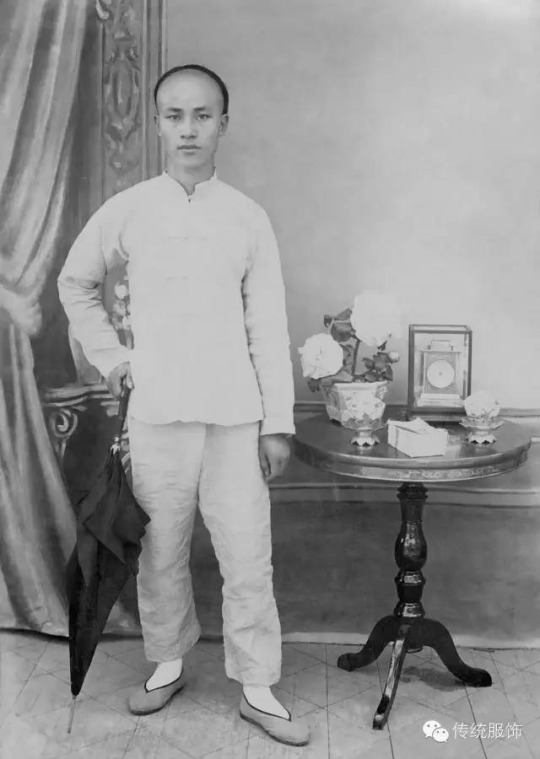
Source here (I’m probably gonna pull most of the menswear photos from the photo album in this article cause they are conveniently dated)
1907 photograph of a certain Mr Ye Jinglv, a legend who preserved his photographs from the 1900s to the 1960s, wearing a 短衫 duanshan short robe and pants.
I have no idea where this collar type came from but the three main suspects are European military uniform collars, Japanese uniform collars (also inspired by European military uniform collars) and Qing Dynasty officials’ collars (now attached to the tunic itself).
As the 1910s progressed, men’s collars gained rounded edges and grew taller just like women’s collars, but they were never so tall to the point that they could not be closed in the front. They were still closed by one plain pankou at the base (men’s pankou has always been plain). This is likely the collar style 6 I identified in part 1 but wasn’t sure about. These collars don’t appear to be stiffened, but rather just constructed of heavyweight fabric similar to the robe itself. Oh and sometimes in photographs you can see men wearing two collars, that is because both the 长衫 changshan, long robe, and 马褂 magua, riding vest, had standing collars in the 1910s, so when both are worn at the same time there will be two collars.
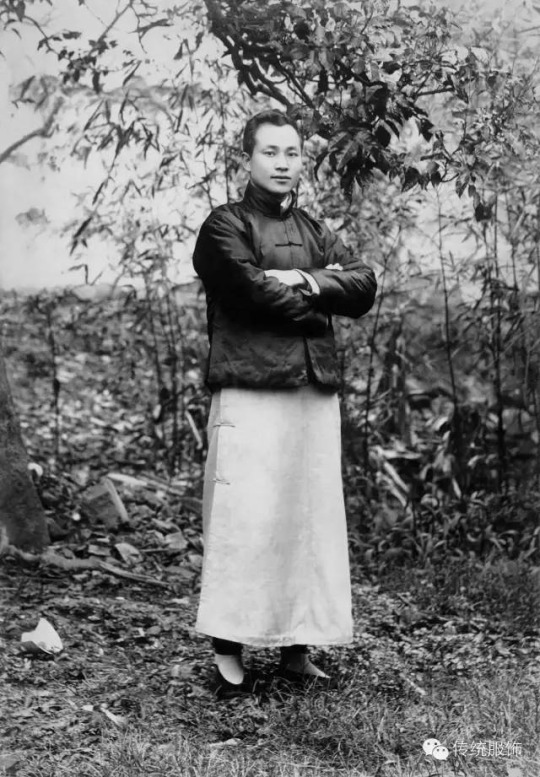
Source here
1916 photograph of Mr Ye Jinglv in a changshan and magua, collar style 6.
1920s
Summary of 1920s Han women’s fashion 1, 2, 3
Going into the 20s collar style 7 went out of fashion completely. The 20s was a wild decade and everything went, but overall collars usually ranged from medium height to tall. There is a wide variety of collar designs in the 20s, women’s dresses with no collar or Western collars like sailor collar, shawl collar or no collar at all etc. all existed, I’ll just list the most common standing collar designs of Chinese origin.
Early 20s collars decreased in height slightly but were still tall standing collars, with rectangular edges, binding and two to three pankous. Let’s call this collar style 9 because it has a will of its own. It’s weirdly reminiscent of collar style 4 from part 1 but the difference is that collar style 4 was unstiffened and had rectangular edges. I don’t think designers in the republican era ever really consciously referenced any historical collar shapes prior to the 19th century... Fashion history was a non-existent academic discipline at that time.

Source here
Calendar painting from 1920 showing collar style 9. It is unstiffened and moderately tall. It has slightly rounded edges, two pankous and a thin row of binding/piping.
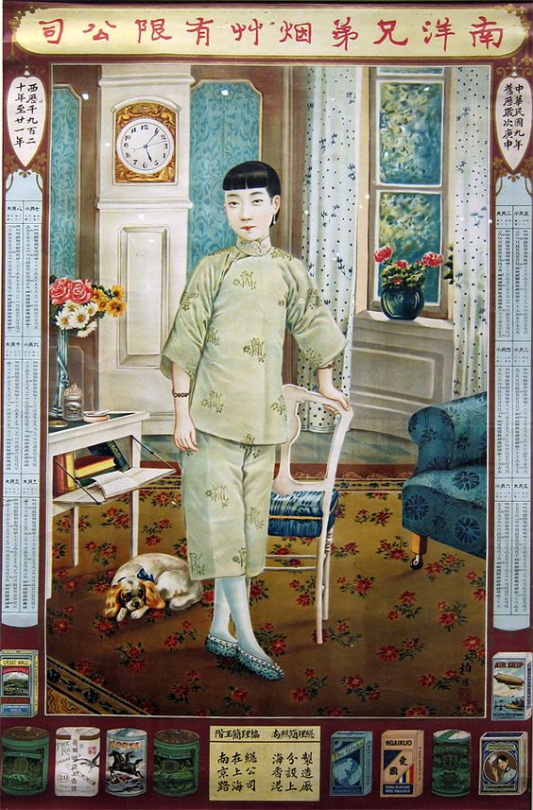
Source here
Calendar painting from 1920-21, showing similar collar style 9 with thin binding and two pankou.
Toward the mid 20s both wide and thin binding could be used and the number of pankou ranged from one to three. I’ve seen multiple times collars with only one pankou at the bottom but still could close completely at the front, which means stiffening was likely used to keep the shape of the collar; I’ll number this collar style 10. The decorations of the mid 20s pursued a tacky aesthetic and were heavily inspired by the 19th century. Alternatively, collars could be decorated with scalloped edges or geometric Western trim. The overall aesthetic was still very 19th century Chinese though. I feel like internal hooks and bars could’ve been used to close these collars, like Western or Japanese military uniform collars, but this is pure speculation.
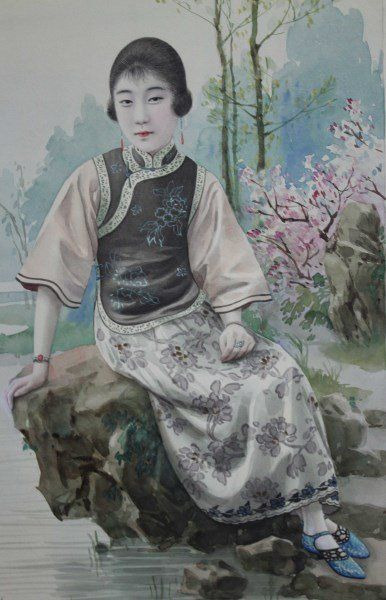
Source here
Watercolor ca. 1926 showing a medium height collar style 10. It closes with only one pankou but holds its shape very well.

Source here or see watermark
Mid 20s artwork showing a similar collar, albeit with thin binding.
Starting from 1928-29 there was this huge trend of using tall, side closing collars. This collar was stiff and structured, tall and closed at the side or back with either pankou or hooks and eyes/bars. It covers the wearer’s neck completely and doesn’t have any openings. This kind of collar was frequently applied to the newly developed cheongsam, which was a one piece dress, to emulate a Western flapper look. The art deco aesthetic was en vogue in the years 1929-31, so there were many cheongsam with innovative closures instead of pankou. I personally really love this look it’s very underrated. This would be collar style 11; it was truly one of a kind since it was never seen again in Chinese fashion history. Rest in Power.
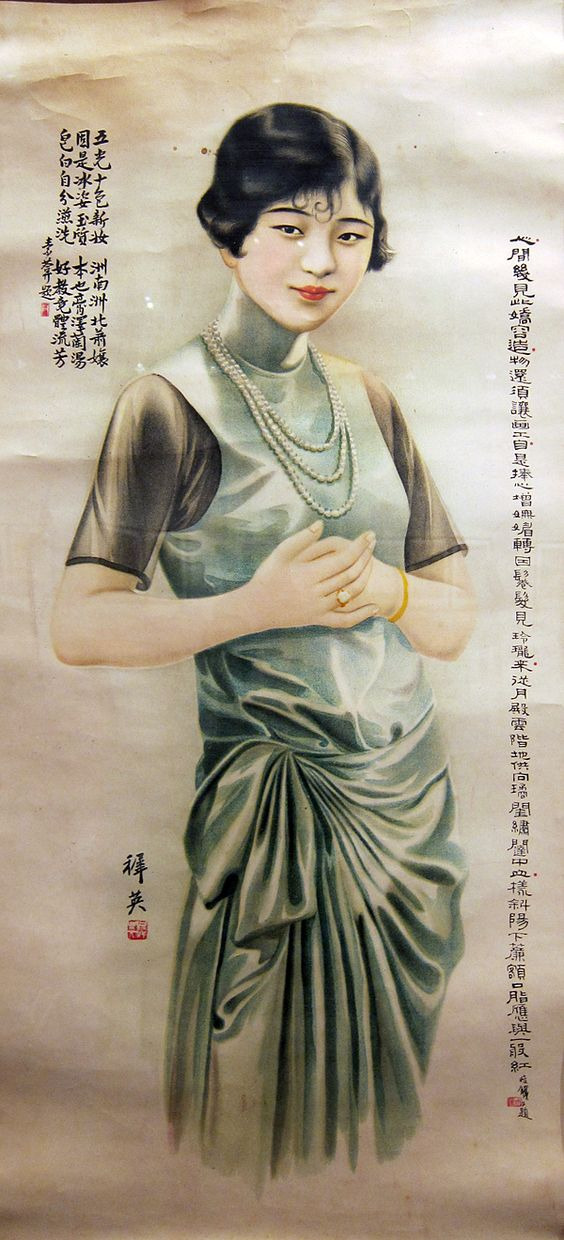
Source here
Painting ca. 1929 showing collar style 11. This is probably closed at the back? Anyway the pankou were not emphasized at this time.

Source here
Kong Sang Hong ad from 1929 showing collar style 11 without visible pankou.
Now menswear again. In the 20s, the tall collar style 6 went out of fashion, following trends in womenswear. The new collar was medium height and still closed by one pankou at the base. It could have either rounded or rectangular edges but rectangular or mostly rectangular edges seem to be more common. I’d say this is similar to collar style 10.
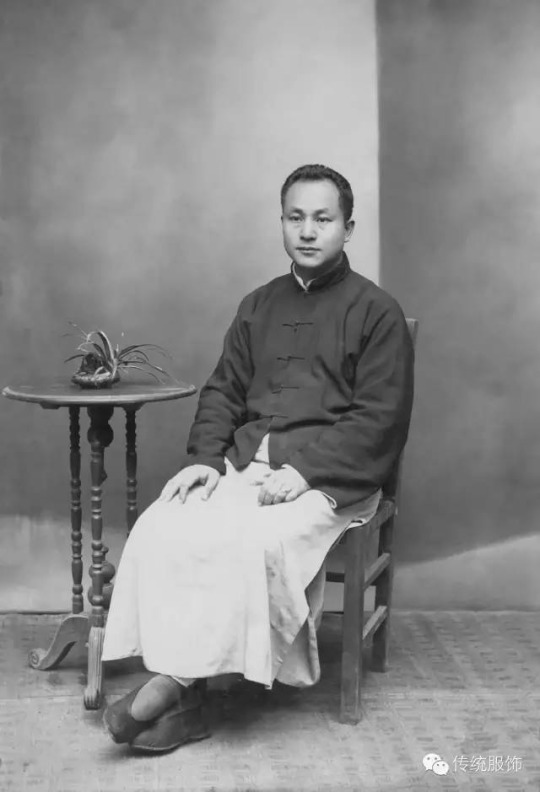
Source here
1925 photograph of Ye Jinglv wearing again changshan and magua.
1930s
Summary of 1930s Han women’s fashion 1, 2
Returning to Han women. Collar 11′s popularity continued to around 1931, when it began to be replaced by a revived version of collar style 8. Collar style 8 with three buttons dominated the majority of the 30s, and these buttons didn’t necessarily have to be pankou; any kind of decorative loop button, clasp or frog closure could be used. 30s collars emphasized the roundness of the buttons, so beads or pearls were commonly used as buttons.
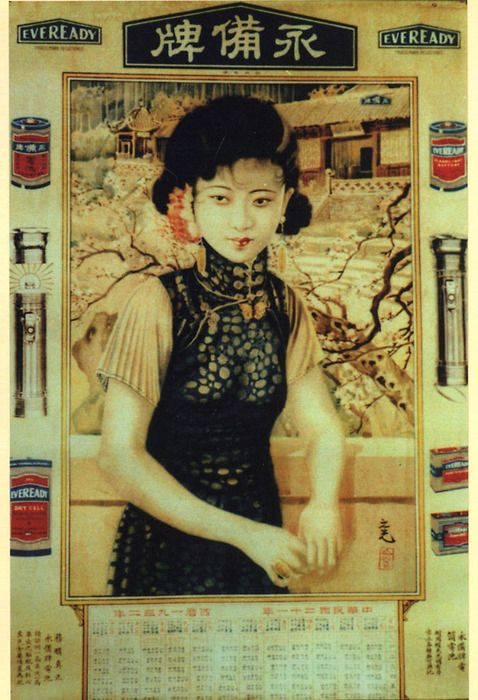
Source here
Calendar painting from 1932 showing collar style 8.
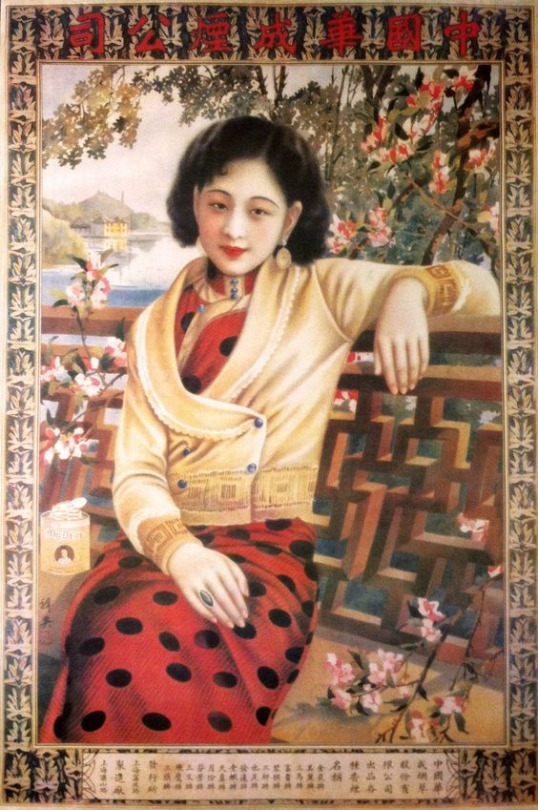
Source here
Mid 30s advertisement showing collar style 8 with bead buttons matching those on the cardigan.

Source here
1932 cover of The Young Companion showing collar style 8 with pearl/bead buttons. Oh collars on a transparent cheongsam would usually be opaque because the interlining/stiffening needs to be hidden.
Men’s collars of the 30s decreased in height again, this time becoming really quite short. Round and rectangular edges coexisted but round edges were still more common. Still closed by one pankou. Not many changes otherwise (gosh, menswear always changes at a glacial pace, y’all men need to step up your game). This foreshadows 40s Han women’s collars so let’s label this collar style 12. Men’s changshan and magua collars stayed this way well into the 40s and 50s.
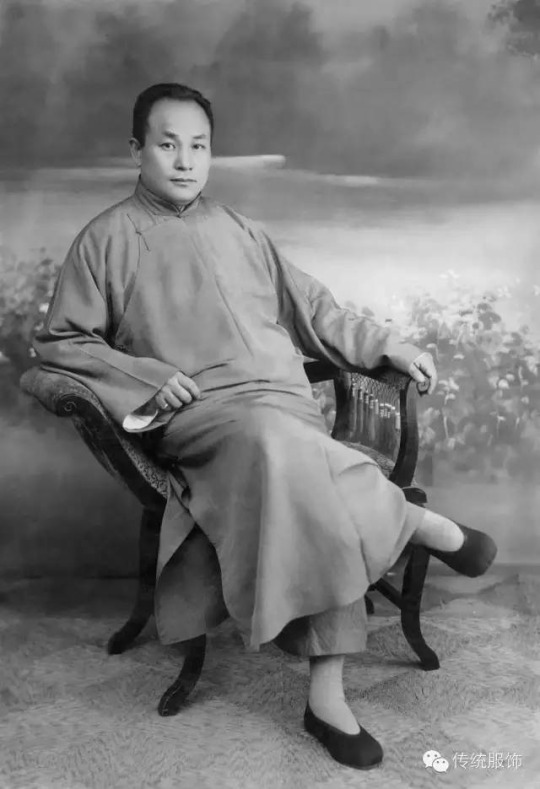
Source here
1935 photograph of Ye Jinglv in changshan with collar style 12.
In the late 30s/early 40s collars dropped in height significantly, regressing to collar styles 9 or 10. It was usually closed with one or two pankou (because there was only enough space for two maximum).

Source here
Late 30s/early 40s artwork depicting the revived collar style 10.
1940s
Summary of 1940s fashion here
As the 40s progressed collars became even shorter, eventually so short that only one pankou could be attached. This developed from collar style 9 but since it was so low and so distinct to the 40s I’d say this is also collar style 12. It may appear similar to collar style 3 from the 19th century but it has rounded edges and is also stiffened and slightly taller.

Source here
Early to mid 40s artwork showing collar style 12.
19th century trims became fashionable again in the early 40s, especially collars with multiple rows of binding/piping. However because of scarcity of materials during the war, that style was only ever seen on actresses and celebrities; cheongsam collars for the average woman were plain.
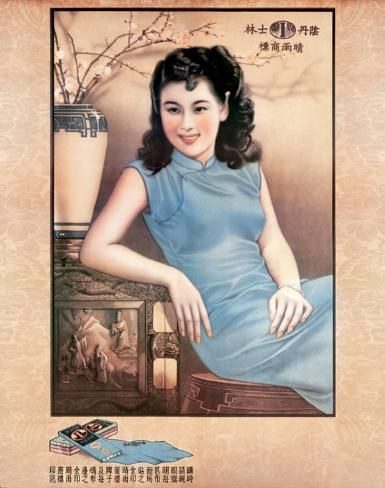
Source here
40s Indanthren fabric ad, showing low collar style 12.
In summary:
Collar style 7: cursed belle époque (ca. 1890-1918) women’s collars that touched the wearer’s face. Extremely tall, stiffened, both rounded and rectangular edges existed. Closed by one pankou at the bottom but sometimes had more pankou for ornamental purposes. Worn by Han women and the plain version for men.
Collar style 8: first appeared in the 1910s, popular in the late 10s and throughout the 30s. As tall as possible without restricting the wearer’s neck movements, stiffened, rounded edges. Closed by two to three pankou. Decorated with wide binding or Western trims like lace in the 10s, multiple rows of binding in the 30s. Worn by Han women.
Collar style 9: developed from collar style 8, popular in the early 20s and late 30s/early 40s. Slightly shorter (medium height), stiffened, rounded edges. Closed by two pankou. Thin binding. Worn by Han women.
Collar style 10: developed from collar style 9, popular in the mid 20s and late 30s/early 40s. Slightly shorter (medium to low height), stiffened, rounded edges. Closed by one pankou at the base. Both wide and thin binding. Worn by Han women and a similar version by men.
Collar style 11: distinctly Western collar, popular 1929-1931. As tall as possible without restricting the wearer’s neck movements, stiffened, rectangular edges. Closed at the side or back with pankou or hooks and eyes. Often plain or of the same fabric as the dress. Worn by Han women.
Collar style 12: developed from collar style 10, popular throughout the 40s. Very short, stiffened, rounded edges. Closed by one pankou at the base. Commonly had thin binding. Worn by Han women and men.
Phew, I thought this was gonna be a short and simple post but it ended up taking way more of my time than I wanted it to. I’m gonna do one last post on the 50s and 60s and maybe address the state of Chinese standing collars nowadays, hopefully that will be actually simple to make lol.
299 notes
·
View notes
Text
Making a Modernized 1890s Skirt - Part 1
I spend a lot of time making historical costumes but I’m just never really able to wear them. In my day to day life I dress rather modern, with a few puff sleeve sweaters and ruffled tops, but overall it’s chain store with a small nod at history. For a while now, I’ve been wanting to make some modernized clothes I can wear on a daily basis, without needing a specific occasion to not look completely out of place (and time). So I decided a skirt was one, super quick and easy to make and two, a perfect way to give my outfits that much needed ✨vintage vibe✨.
This idea has been in the back of my mind since I watched this video by Bernadette Banner, I haven’t rewatched it since but I would say it is loosely based on it.
The idea was that I’d use the skirt pattern from the Anne With an E dress, as it was taken from an actual 1890s skirt pattern that I just shortened. So immediately when I received my package, I started working on it.
I didn’t need a mock-up as I’d successfully used the pattern before, so I cut it out of the fashion fabric right away - I’d bought 2 meters for this but honestly could’ve done with one. But having leftover twill is never a bad thing, there’s so much you can do with it!

As you can see, there are three pieces. Two of them I cut on the fold, so they’re double the width, and the third one is actually two seperate pieces, same shape but mirrored, those will be the side panels.
Next I stitched them all together and cleaned up the edges right away. So much easier to work like this.
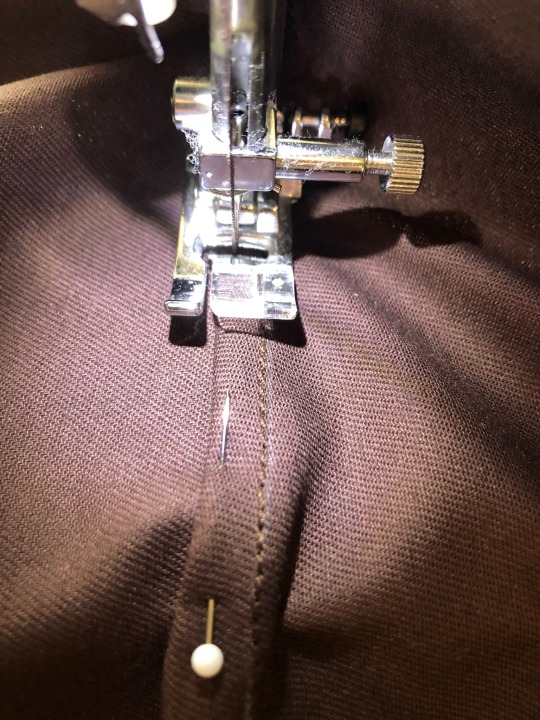

Now it was time to pleat the back. I eyeballed it, pleating the entire back panel with pins and then tried it on to add some pleats to the side panels as well so it looks a little better.
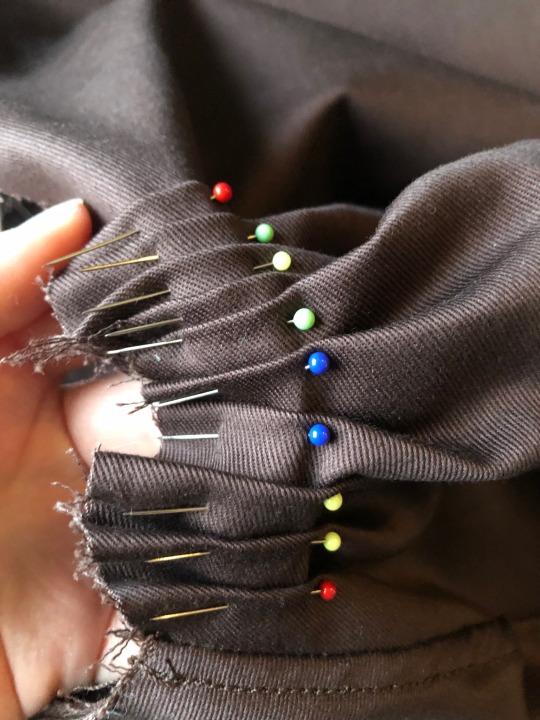
I then decided to stitch down the pleats so I could take all the pins back out; it was impossible to add the waistband with them in place.
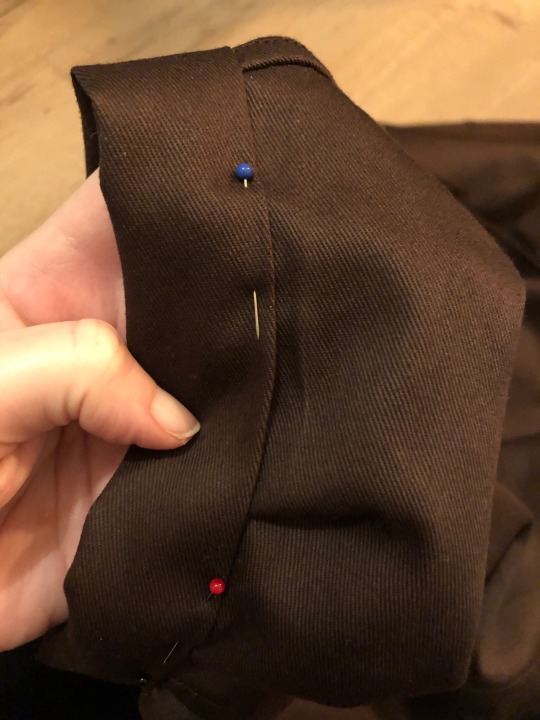
For the waistband I just cut out a rectangle, pressed it and sandwitched the raw edges and pleats between it. It was a little finicky but thankfully once pressed the fabric stays in place pretty well.
Next up was the zipper.


This was actually the first time I used a zipper foot, up until now I either sewed it by hand or used a regular foot, but it worked so well and i’m never not using a zipper foot again.
And that was it for one day of work. I’ll be finishing up the skirt asap and maybe even do a photoshoot, who knows!
#fashion#historical fashion#fashion history#victorian#victorian fashion#sewing#skirt#victorian skirt#edwardian fashion#mysewingadventures
42 notes
·
View notes
Photo


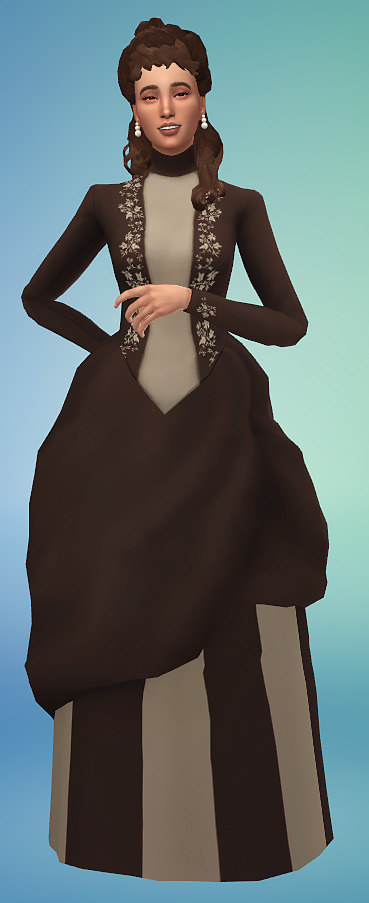


So I thought I'd put together some lookbooks for a few decades and talk about the fashions of the time, in the hopes that y'all might find it helpful to put looks together for your Decades challenge.
What I'd like to do is break down the outfits by undergarments, dresses, accessories and hairstyle and explain what was the fashion of the time, and give you the CC links to achieve this look.
Full disclosure - I am no expert. The information I'm conveying here is gained from my independent research, but take it with a grain of salt and do your own research too!
I’ll try to do some more looks soon.
Full breakdown and CC links under the cut.
Firstly, it's important to know that, like most people nowadays, not everyone had the latest fashions the very year they came out. Dressmaking was a time consuming and expensive exercise, and it was common for people to unpick and make over existing dresses into new styles. So if you hit 1890 and don't have a super rich Sim, it's okay to put them in a dress that is closer to 1888 - 1889.
Undergarments
My townie, Adina, is wearing what would be worn around this time period: a chemise and drawers, and a corset. Contrary to what period dramas often portray, women did not wear a corset against their bare skin, because corsets were meant to be comfortable support garments.
Corset | Drawers
Look #1 - Walking Ensemble
I use the term ‘walking ensemble’ loosely, because generally the walking skirt falls to the top of a woman's boot hem, allowing her to walk without dragging the hem of her skirt in the dust. But I digress.
It's important to note that it was frowned upon to step out of the house without gloves and a hat for many decades, so get used to picking out gloves and hats for your looks. It's fun, I promise!
This look is appropriate for around 1890 - 1892. Take it with a grain of salt, as it's based off an EA mesh, and probably not super historically accurate. But with the tailored bodice and waistcoat and overskirts, you could make it work IMO.
Hair - hairstyles in the early to mid 1890's are pretty vertical, swept up and pinned under a hat often trimmed with feathers or flowers (or both). Towards the mid to late 1890's it was common to wear stuffed birds on your hat; in fact it was so popular that it took a lot of bird species to near-extinction :| so not fun.
Shoes - sensible walking shoes aka the Victorian button boots, that all-rounder type of shoe, which comes with the Vampires pack, or a lace-up version unlocked with Get Famous.
Hair | Dress | Gloves | Hat
Look #2 - Day Dress
This look is probably more of a house look for late 1889 - early 1890's, as it doesn't include gloves or a hat.
Hair - as before, the hair is piled high on the head, with some strands falling over the shoulders. One thing nobody talks about is that from about mid 1880′s to about the mid 1890′s is that little curly-frizzy bangs were in style, so I’ve added them on to Adina’s outfit. If you’d rather not deal with the horror of that, you do you.
Hair | Bangs | Dress
Look #3 - Evening Wear
Anything that exposes the arms and shoulders is generally reserved for evening and formal wear.
Gown - the dress from Get Famous or a recolour is my favourite to use for the 1890′s. Any dress that doesn’t expose too much cleavage and is floor length (at least) is good. White gloves were worn.
For the dress, you can use Get Famous’s dress, or a the number of recolours, and the base game long white gloves. Pearls were common, as were stones.
Hair - worn in a high or low coiffure, often with hair accessories like brooches, feathers or a tiara.
Undergarments - as normal, though I believe silk stockings would be worn, as well as low-heeled pumps. The shoes I’ve linked are a classic style that I believe would work under this gown.
Gown | Earrings | Necklace | Shoes
Look #4 - Riding Habit
By the early to mid 1890′s bicycles were increasingly popular, especially with women, but horse-riding was still a pastime for the wealthy. Because, IMO, there is no suitable bicycle jacket (yet 👀), I thought I’d put together a riding habit look.
Hat - lil top hats were common, underneath swept-up hair (same hair I used in look #2.
Dress - I couldn’t really find anything closer than this. Normally it’s a well-fitted buttoned jacket and a skirt that can be buttoned up to allow freer movement. I settled for a separated bodice and walking-length skirt. Or you could download the outfit that the hat comes with.
Hat | Bodice | Skirt (New Woman set) | Boots
181 notes
·
View notes
Photo
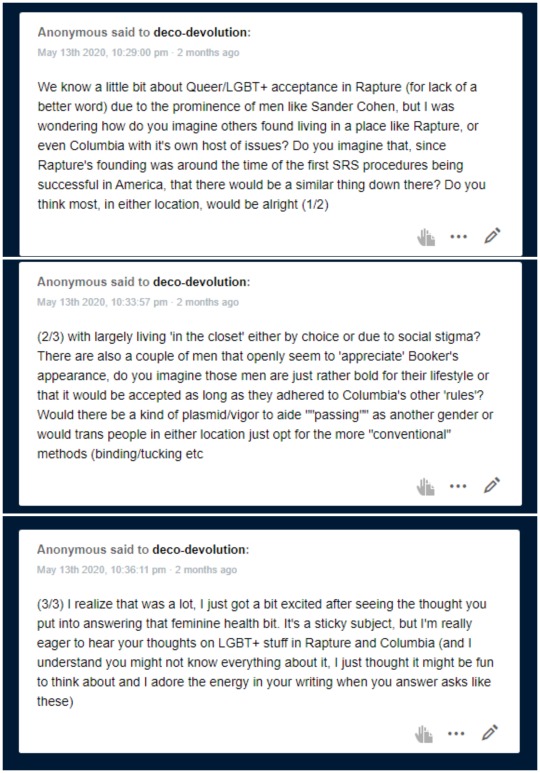
Sexuality & Gender In Columbia
Okay, so this is a frankly huge topic to cover, and because there is so little direct reference to any non-heterosexual/cisgender culture in the games, a lot of this will be me sharing/explaining my headcanons/worldbuilding. My ideas will be based on historical record of LGBT+ struggles at the time (1890-1915) and mostly US-centric, as Columbia seems to be fairly westernized. in addition, I will be focusing purely on the lesbian, gay, bisexual and trans communities to cut down on post size and research time. Here we go!
Note: These all refer to Columbia (Rapture has a separate post) culture in the peak of the city’s life- a snapshot into queer Columbia circa 1910, roughly speaking. As such my talk about the culture is purely as I’d imagine it to be at that specific time only with no details as to the cultural development to that point.
cw for homophobia, transphobia, q slur


Sexuality In Columbia
If you’re not straight it’s over for you
Quips aside, just from playing the game you can tell Columbia is ruled by the most staunch of conservatism. The Edwardian Era in real-world history made heavy emphasis on modesty and a sense of duty but Columbia takes it a step beyond, and this can be seen in most every example of media or dialogue found in-game. Having such traditional Biblical leanings, it can easily argued that this also extends to sexuality.
Right off the bat, I feel like this is Heterosexual (& Cisgender) Land™. Any other sort of attraction, be it gay, bisexual, or anything else, is considered reckless experimentation at best and ungodly and deserving of punishment at worst. Aside from the religiously-motivated belief that only straight relationships are legit, there’s another reason they’re so heavily emphasized- population growth. Columbia, for all its pomp still has a relatively small population on a national scale- just from some educated guesses I’d put it around the borough to town region, as indicated on the settlement hierarchy of ekistics. While the limited space of the city means that the population can’t just continue to grow, a certain rate of births is needed to keep the population level.
Interestingly enough, even though Columbia is a hotspot of religious zealotry, the city still follows the conventions of Edwardian/Early WWI society- very proper, highly formalized in its ideals. Aside the propaganda and fearmongering, personal details are still taboo in polite conversation.
Cruising is done in places where social conventions are significantly different from formal events or even everyday conventions- namely the beach, pubs and lounges.
In the same vein, hookups, flings, and dates are called vague things like “going out to lunch/drinks”, “going for a stroll” or “having a picnic” and same-gender partners are typically referred to as close friends. It’s all very underhanded, the result of both Edwardian discreetness and closeted language.
Gender In Columbia
Like most of Columbian society, the queer groups in Columbia tend to gather based on gender. Lesbians share space with bisexual women, and gay men stick with bisexual men. As far as trans communities go, however, the cisnormative, rigid interpretation of gender predominant in Columbia means that they tend to be misunderstood among the other queer groups. Typically not in a blatantly hostile way but rather an obnoxiously condescending “poor confused dear” way.
Gender is not so much an identifier as much as an determinator; whatever you are assigned will be the factor driving not only your upbringing but your life choices as well.
There are quite a few social clubs that operate as safe spaces for the community- they typically rotate between the members’ houses and frequently merge or splinter with or from other groups, going from book club, to knitting social to any other politely banal gathering.
For those looking to dress how they’d like in safety, ‘costume clubs’ are popular among gender non-conforming, trans people and those interested in crossdressing. They present themselves as sort of novelty dance halls with every day being a masquerade. While technically legal, their image is strongly connected to immorality and looseness in Columbia and as such they’re rare and subject to higher levels scrutiny then other halls.
Because of the rigidity of the culture, the LGBT+ culture in Columbia uses nonverbal queues to state their identities- for example men place certain flowers in buttonholes or alternatively pin them to their lapels to let outsiders know they’re in the community. Women can put these same blossoms in their hats, brooches and hair. These include flowers such as lavender, violets, pansies, carnations and daffodils.
There are HRT gene tonics for sale- they’re marketed under the guise of improving a woman’s femininity or man’s masculinity, they’re sold in pharmacies in the health and beauty aisles without the need for a prescription. This helps some looking to transition do so much easier, though the issue of financial barriers for those who are younger and/or living in poverty still linger. As far as options like SRS go, the procedure is entirely underground, practiced by surgeons of varying repute. While being able to do so successfully is considered a show of skill, most practitioners and citizens are morally opposed to the idea.
Unlike Rapture, there’s not many fun or quirky terms for LGBT+ citizens. Those with same gender attraction are rudely referred to as “victims of unnatural passions” and those who ID as anything other then cisgender are accused of “falling into delusions of identity”. Among themselves though, WLW call themselves “Lady Lovers of Liberty” (as in the statue based on the Roman goddess Libertas) while MLM call themselves “Sons of Antinous” while trans citizens typically refer to themselves as “Children of Agdistis”. (Note that while Agdistis was portrayed as intersex in Roman mythology, their nonbinary existence and transformative identity made them a relatable icon for most trans people in Columbia)
Questions or comments? Let me know! Thanks for reading.
129 notes
·
View notes
Photo
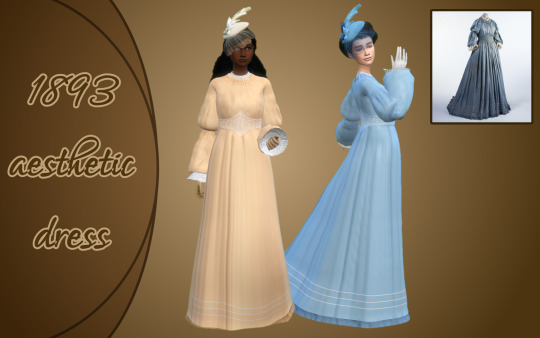
1893 aesthetic dress
03.10.2020 edit: fixed a problem with the mesh getting spiky when watching a sim walk from a distance. Please redownload!
***
Hello everyone!
Today I bring you something I've been planning on making for ages: an artistic / aesthetic / reform(ish) dress for your sims. It's not a full blown reform gown - those became the thing only a couple of years later - but it definitely is influenced by the whole dress reform movement. In case you've never heard of it - beware! Here comes a tiny 'history corner' section:
It all started with the Pre-Raphaelite Brotherhood, a bunch of artists who found the Victorian fashion - especially female - too stiff and unnatural. They were rather fans of long, flowy, loose medieval and renaissance gowns (as you can easily guess from any of their paintings). And that's what they were trying to promote; to reform the way women dressed. They weren't extremely successful at it, as you can see looking at the majority of Victorian fashion plates, but with time the whole idea was getting more and more recognition. There were designers - and brave fashionistas - who liked the whole concept and enjoyed creating (or wearing) what they called 'artistic' or 'aesthetic' dresses. In early 1900s those dresses - now known mostly as 'reform gowns' - kind of made it to mainstream and even though they never replaced the 'proper' fashion, they were at times advertised alongside 'normal' dresses. Judging by how fashion developed in later 1900s and 1910s, I'd say the whole movement did make a difference in fashion history.
As cool as artistic dresses were, you have to remember that they could be worn only by the chosen few. Firstly, you had to be rather rich, as back then - just like now - art wasn't cheap. Secondly, you needed a proper social standing (and probably also the right character for this). Aesthetic dresses were VERY different from the mainstream fashion; especially in 1890s, the decade infamous for tight lacing, wearing something so loose that you could basically not wear a corset underneath at all (not explicitly encouraged, but everyone knew the option was there) made you look like a... Well, either a trendsetter or a weirdo, depending on how influential you were. And thirdly, you also needed a certain figure - tall and slender - to pull off this look, otherwise you could easily end up looking as if you were dressed in a sack. Imagine if that was what We wear bags meant! The whole neighbourhood running around in reform gowns XD
Sooooo, after this long introduction, here it comes! In 20 swatches:

polycount: ca. 7K
Base Game compatible
HQ mod compatible (...)
all LODs
custom thumbnail, bump and specular maps, some very gentle shine
tagged as everyday, party and warm weather (idk, looks like it could work for summer?)
found under long dresses subcategory
colour tagged
disallowed for random, as only chosen few blah blah blah
PDN for recolours included - you don’t need it for the mesh to work. Let me know if you’d rather have the PSD file!
I haven't spotted any problems, but let me know if you notice any.
Hope you'll like it, enjoy!
DOWNLOAD (free on Patreon, no ads)

***
Terms of Use
Don’t: claim it’s yours or monetise in any way
Do: convert, recolour, include the mesh, edit the mesh to create something amazing - just please tag me once you publish it, so that I could also see it!
#ts4cc#vintage#victorian#1890s#adultfemale#outfit#dress#day dress#reform gown#artistic dress#aesthetic dress
515 notes
·
View notes
Text
Tempest (Pt. 1)
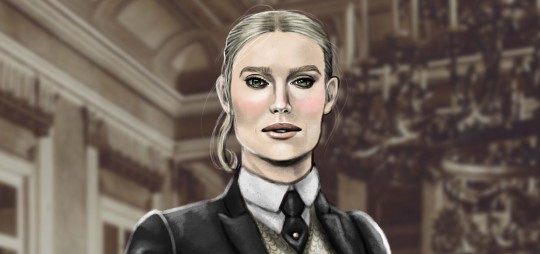
Part 1 | Part 2 | Part 3 | Part 4 | Part 5
Read on AO3
Pairing: Ava Du Mortain x f!Detective
Wordcount: 1950
Warnings: gay pining, denial of romatic feelings none
Summary: Ava waits for the private detective to arrive while pondering their relationship. (1890s AU)
A/N: I am plagued by the late Victorian AU and Miss Du Mortain, so this happened. I wrote the detective as a female private detective, but other than that I have not specified any details about her. It also passes as a reader insert fic! (You can check out the full art here.)
Ava watches the grey sky as it persistently batters the window with rain, the small streaks on the glass pane casting lines on her handsome face that could be mistaken for tears by someone who doesn’t know her. Anyone who does know her knows that she’d sooner shed her blood than her tears. That is just the way she is. The way she likes to be thought of. The only way she is truly safe.
The heavens have let loose, and god is baring his teeth. And Ava just stands there, hands shoved in the pockets of her trousers, gazing out into the busy street as still and cold as the marble statues dotting the hallway. But only on the outside. Because inside of her, there is a storm to match the tempest that assails the city.
She is agitated the moment an image of her slips into her mind, and she begins chewing on the inside of her cheek when she realises that every minute the private detective isn’t in her sight, she is losing her mind. The nervous gesture is soon quelled by hundreds of years of self-discipline, and is replaced by her signature frown, lips pressed into a thin line, the muscles running along her jawbone tensing under her opaque skin. She is... mortal, she wants to think. Fragile. Unimportant. A job.
But she is also everything.
Which is why she must sever her ties to the woman before the job is over, otherwise the eternity to come will turn into hell on earth without her. Ava deserves hell, she knows that. Not that she believes in the devil, but the sharpness of his pitchfork and the heat of hellfire are sensations not unfamiliar to her. Eternal damnation is just guilt and anger and fear hiding in Satan’s clothing. But she can’t even begin to assign words to the kind of torture a world without her would mean. Ava’s ever so logical mind paralyses in terror at the thought of existing in a time when she isn’t.
She inhales sharply - even brushing the surface of the topic causes so much pain to course through her whole being that she needs to focus on something else - anything else - to continue functioning. So she listens to Nate’s soothing voice as he discusses myths with the professor down the hall. She registers the footsteps of people mulling about the museum on the floor below, the idle chatter of ladies clad in expensive dresses, the booming voices of three men arguing over the origin of a painting in the first hall. She turns her piercing attention on the street now, listening to the sounds of horses and vendors and street urchins, feeling thankful to the steady rain for considerably dulling the sharp tang of the muddy streets in her nostrils. She pulls out her pocket watch then, the ticking matching her now once more steady heartbeat.
The detective isn’t late yet, though she has a feeling that she will be, with the rain clogging the streets with carriages and hansoms as it usually does, especially at such a lively hour in the late morning. Ava wonders what she will wear, how her hair will be styled. She wants the rain to kiss her face, she wants the wind to rake its fingers through her tightly pinned up hair and loosen some strands from their captivity. She wants the warmth of the museum building to engulf her once she steps inside, bringing a rush of blood to her cold cheeks. She wants all this and more, for her own body must stay still for everyone’s sake, thus leaving her to live through the rain, and the wind, and the warmth of the radiators, her own fingers and lips and skin left yearning for a sensation she must deny herself.
Her daydreaming is cut short when two men pass her by, throwing her wide-eyed stares as they clutch their books to their chests and mutter quiet greetings to her. Students of the professor, no doubt, and shocked to their very core by the sight of a woman in trousers easily towering above them. It fills Ava with a savage sort of satisfaction before her insecurities - awakened by the private detective’s appearance in her life - creep up on her. It has never been particularly acceptable for a woman to wear men’s clothing throughout history, and 1896 is no exception. Then again, Ava has never been particularly bothered by this expectation, so it has all been well. Until now, when she begins to wonder if the detective likes this. She has commended her on her bravery before, and agreed with her choice of clothing because of its practicality, but that is hardly an admission of approval or attraction. And besides, she seems to favour dresses herself, even if she is nowhere nearly as extravagant or tightly laced as the dames of the decade. Admittedly, the detective’s pulse always picks up when they speak, especially alone, and her pupils are blown when she catches her staring but...
“I’ve got what we came for... and more,” Nate speaks with quiet excitement as he stalks up to her by the window, and Ava forces herself to look at her friend, hands balling into fists in her pockets. She had been so absorbed in thoughts of the private detective that she almost didn’t notice Nate at all until he reached her.
Pathetic. She needs to focus.
There’s a supernatural on the loose, murdering in the streets of London, and she is thinking about whether or not a mortal woman likes her choice of clothing. She takes the folder Nate hands her, and pries it open to reveal several new pages filled with his neat handwriting. At least their initial hunch has been correct - they’re definitely something corporeal that can pass off as a human, and now thanks to Nate’s research, they’re all but confirmed to have come from Scandinavia originally. And yet it doesn’t help her ease her mind that she knows what they could possibly be - after all, they’re out for the detective by the Agency’s estimate.
“Could it be a dark elf?” she mutters, blonde brows furrowed as she skims through the pages.
“Dökkálfar. My thought exactly,” her friend nods, pleased that Ava has come to the same conclusion.
“Haven’t seen one of those in... well, in a very long time.”
Nate’s shoulders sag a little as his initial enthusiasm ebbs. “I suppose we are about to face one again.”
She wants to reprimand Nate for forgetting the real objective of their mission - it’s protection, after all, not hunting down a rogue. But she thinks of the detective again, a woman so unique and individualistic in a world that tries so hard to oppress her along with her ambitions, and she knows she won’t be able to rest until the threat to her life is no more. It’s her duty, she reasons meekly against the swell of affection filling her chest and pushing against her skin, threatening to crack the solid marble of her stoic facade. But she knows a lie when she hears one. She suddenly thinks of last year, Paris, the Louvre. Nike of Samothrace. The statue of the Winged Victory. Headless, and yet still the symbol of triumph. She has lost her common sense ever since she started working with the detective, but she knows she must win as well, because if she fails... Well, she dare not even think about the consequences it would have on her.
And above all, she must remain as cold to the touch as that carefully carved block of marble.
“I wish we could tell her,” her friend presses on gently, concern and guilt marring the edges of the soft curve of his long lips.
“It’s better this way. Safer,” she croaks, hating the way her voice softens and breaks mid-sentence.
“Safer for whom, I wonder?” Nate sighs, taking the folder Ava hands him and closes it with delicate fingers before leaning against the wall next to her. She hasn’t even realised she sought to support of the wooden panelled hallway until Nate mimicked her movement absent-mindedly.
“What do you mean?”
“Safer for her...” he sighs before glancing at Ava with sad eyes, “or safer for us?”
She averts her eyes, her long ignored self-loathing clawing its way up from the deepest pits of her mind before she clenches her jaw. “For all parties involved.”
But mostly for me, she admits to herself inwardly. The lie obscures her true nature, and she revels in it for once. She doesn’t know what she’d do if the detective flinched away from her in fear instead of being drawn to her like a moth to a flame in the middle of a heavy summer night. For the past 800 years, she thought of herself as nothing but an agent, an element operating in the shadows, making the world a less dangerous place. She hunted her emotions and burned them at the stake, but this witch hunt can only go on for so long without consequences. She always thought of herself as a vampire first and foremost, her base nature being a bloodthirsty monster, but she was human before that. And she’s never felt more human than now. Probably not even when she actually was one.
And that is a terrifying thought to live with, especially when its source is so easily pinpointed. Her. It’s all on her.
“So we lie once more?” Nate sighs, breaking the silence and drawing her attention outwards once more.
“Yes,” she states firmly, the word feeling strangely sour in her mouth. “We tell her this was a dead end. She doesn’t need to know anything else. The Agency, on the other hand, needs to be brought up to speed. Will you do it?”
“I’ll brief them,” Nate nods, pushing himself away from the wall before straightening down his coat. “I suppose that leaves you with watching her?”
“Yes,” Ava speaks through gritted teeth, ignoring the heat crawling up her neck at the thought of being alone with the woman. Her reaction to the detective is unbearable, and yet she brings it upon herself like a masochist inviting the pain. She doesn’t understand why she does it, and yet she has no will to stop.
A nod, retreating footsteps, and Nate is no longer to be seen or heard, not even by her eyes and ears. She slips out her watch from her pocket once more and flips the silver lid open - she is late. Her heartbeat turns into a wild galloping crescendo when she hears a familiar voice on the street though, her heart’s rhythm no longer matching the steady ticking of the pocket watch as it did before.
Ava stares as she exits the hansom with a graceful ease that should be categorised as a criminal offence, wet pieces of stray hairs sticking to her delightful face as she rushes across the street with a purpose that almost leaves her breathless.
She wants to catch the killer, she tells herself. That’s all she wants and nothing more.
Yet as she moves swiftly towards the staircase, unable to wait for her in one place, and wanting, no, needing to see her as soon as possible, deep down Ava hopes the detective is just as eager to be with her as she is.
And then at the very last moment, right before they’re about to come face to face, she schools her features into a blank expression, a great lie of a tabula rasa, her face hardening like sculpted marble - commanding, ancient, beautiful, but so, so cold.
#dottiechan writes#ava du mortain x detective#a du mortain x detective#the wayhaven chronicles#twc fanfic#twc detective#ava du mortain#a du mortain#what the fuck is proof reading y'all#also it's been a hot minute since i last posted any writing
36 notes
·
View notes
Note
Do you know anything about the costuming in The Alienist? I've seen some gifsets where the hairstyles seem off.
So
The Alienist
Haven’t seen it. Will not see it. Feel strongly that their attitude towards corsets- the scene where the main character is undressing, dramatically reveals angry red marks on her chemise-less torso, and wryly ponders why men force corsetry on women -demonstrates a total lack of respect for the realities of Victorian women’s lives. And an inability to put aside preconceived notions and learn from real history. If you won’t listen to women past and present who said/say that corsets aren’t inherently torturous, what else won’t you listen to us about? It seems like a small thing, but it destroys any trust I had in the writers re: bigger issues.
(Which sucks because, based on Googling, the costumes actually look pretty good. There’s a formal dress I’m kind of :/ about, but I can think of like one similar extant gown I saw once, so.)
(The hair looks mostly fine. It’s up. It looks eminently practical, perfect for a no-nonsense professional woman. Side parts are kiiiiind of starting to be okay in the 1890s. I love it, honestly. The writers probably think it’s a symbol of the character’s Evil Patriarchal Fashion Oppression. If there’s a scene where she sighs that men won’t let her wear loose beachy waves, I won’t be at all surprised.)
#ask#period drama#historical costuming#costuming#monstrousgourmandizingcats#you know what else leaves marks on your abdomen?#LITERALLY ANY JEANS#ESPECIALLY SKINNY JEANS#FUNNY HOW NOBODY EVER BRINGS ~THAT~ UP
40 notes
·
View notes
Note
1, 2, 15, 16, and 31 for Ru? Need more info on cool new guy!
Hahaha, yes! Let’s talk about my Kelpie Kid! <3

1. Their gender expression re: whole spectrum.
Ru is genderfluid, accepting both he/him/his and they/their pronouns. They largely present as male just out of convenience, since male fashion from that period (1890′s) is a little easier to move around in and doesn’t have as many layers, and because the person Ru took the place of was a boy.
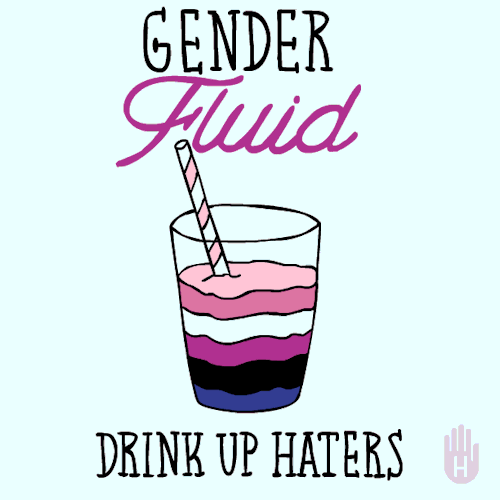
2. Their sexuality re: whole spectrum.
Ru is ace/pan! Though they wouldn’t really think to describe themselves that way. But logically, they are a kelpie interacting with a bunch of humans, so any romance they might ever cultivate would likely be primarily built on romantic attraction.

15. Do they collect anything? Do they control it or it controls them?
Hogwarts is the first time that Ru’s ever had a more “permanent” base of operations, so they’ve taken to collecting a lot more than they ever did previously, now that they have a safe place to keep personal belongings. Their favorite and most standard things to collect are books and thamatropes, but they also have a bit of a problem with holding onto stupid, quirky things like a shard of green glass from a broken bottle or an oddly shaped chicken bone from lunchtime, just because it tickled their brain somehow. Over time they transition into taking pictures of those things, so as to slim down the amount of bobbles they keep.
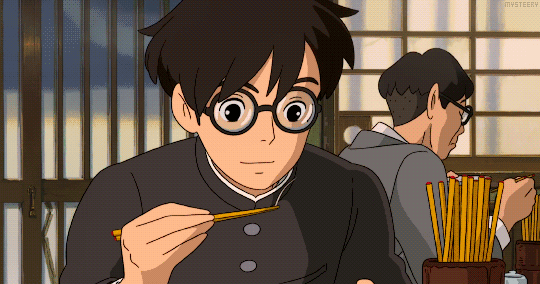
16. What’s their taste like re: interior design, art, gadgets? If they have (had) money - antiques or modern design? Ikea or whatever? Art collecting, fashion, wine? Pokemon cards in the 90s?
Ru’s fascinated with photography. The recreation of the real world in a small, portable form that can outlast its subject is ridiculously enchanting to them, so they tend to gravitate more toward the Realism art movement, even if it’s considered a bit old fashioned compared to the “newer” Modern art movements of the Victorian era like Impressionism or Expressionism. That being said, even if they like realistic art more than the more abstract, they really enjoy it when realistic artists try to visualize the supernatural or impossible, so I could see them being the sort to enjoy Rene Magritte’s “Surrealist” art from the 1920′s. Ru also is absolutely entranced by thamatropes, zoetropes, phenakistiscopes, and “moving pictures” -- in their seventh year, they pulled some strings to get their hands on a cinematograph of their own and subsequently used it as much as they possibly could.
When it comes to home decor, Ru isn’t picky. As long as it’s relatively dark so they can develop pictures and has walls, a floor, a ceiling, and several doors and windows, that’s all they really look for. It’s likely that they’ll sort of just pile it high with haphazard stacks of books, developed and undeveloped magical photographs, and random sheets of parchment anyway. XD
Food-wise, Ru’s rather flexible about what they eat, though they definitely prefer their meat on the rawer side...but one particular quirk of theirs is their distaste for eating around anyone else. Because they’re used to having to fight with other animals like grindylows for food, Ru even now tends to wait until everyone else has left the Great Hall or take their food out of the Hall with them so that they can eat alone.

31. Their fashion sense as they age - describe it. Is it dead but delicious? Necromancer Barbie? Mall shop goth? Wannabe Parisienne? Do they belong to any subcultures? Any tattoos, piercings?
Ru tends to dress on the dishelved, but colorful side, with a lot of loose ties, unbuttoned collars, brightly colored jackets and waist coats, and black top hats. Their favorite colors to wear are in the blue/black/gray/green color palette. Although Ru presents male, however, they wear their hair much longer than their contemporaries, and they’re fond enough of jewelry that they frankly don’t care what gender that jewelry was “meant” for. The constant is an enchanted silver chain around their neck, which was, er...”bestowed upon them” by a certain part-Veela Hufflepuff @that-ravenpuff-witch, to serve as a “bridle” of sorts. ;) They also love wearing rings and earrings -- it was very scandalous to both the Hogwarts staff and the Ollivander family when Ru decided to pierce their ears, which was decidedly not something an upstanding gentleman of the era would do. *snort*

World-Building Ask!
7 notes
·
View notes
Note
Could you do something about how the Tucks/Winnie would dress? Thank you! I love your content!! (Tuck Everlasting)
Thank you so much! Apologies for how long it took me to answer this, I hadn’t listened to the Tuck Everlasting musical before receiving this ask so I had to take some time to do a little research on the show (I loved it, by the way).
So, it’s a little bit difficult to give you an exact answer as to how the Tucks would have dressed since they lived through many different decades in history before the events of the show, and each of those decades had a unique style. However, because I wanted to give some kind of answer to your question, I decided to put together a brief summary of how the Tucks would have dressed in their original time (1808) as well as a bit at the end about how Winnie would have dressed in 1893. I hope this answers your question!
Jesse, Miles, and Angus
Men’s fashion at the turn of the 19th century was moving in a different direction from past decades. There was more of an emphasis on the natural form of a man, and an immaculate look was also heavily favored. As a more middle-class family, however, Jesse, Miles, and Angus likely wore clothes like that only for fancy occasions.
For day-to-day wear, tight-fitting breeches that ended just below the knee would have been worn, along with a more loose-fitting shirt and waistcoat (or maybe no waistcoat). These likely would have been made of linen or wool (but probably not cotton, as cotton clothing had yet to become very popular). Shirts and waistcoats during this time often had high collars, and cravats were also worn for fancier occasions.
For colder weather, or if they were going somewhere where fancy clothes were required, they would have worn an overcoat or greatcoat made of wool. These coats were short in the front, ending at the hips, with long tails in the back. In terms of colors, dark but still vibrant colors were preferred, such as a deep blue, red, or green. Leather boots were the most common choice of footwear for men, and these were worn with wool socks or stockings. Top hats were the main choice for headgear when going out, and hair was starting to be cut short (although many men did still wear their hair long and tie it back into a ponytail).


Mae
Mae’s clothing would have looked similar to the dress she wears during the flashback in the song “My Most Beautiful Day” (although that dress is anachronistic since her most beautiful day would likely have taken place in the late 1770s based on how old Miles and Jesse are, but that’s a topic for another time). Empire waistlines and Jane Austen-style dresses were the fashion, regardless of a woman’s social class.
To start with, a shift and stockings made of wool or linen would have been put on first, with the stockings being held up by garter ribbons. Then the shoes would have been put on (usually flats with little to no heel for everyday wear). After that came the stays, which had evolved to be extremely similar to the corsets which were popular in later decades (again, there is a slight difference between stays and corsets, but at this point in history the line becomes a bit blurred). Stays could either be long (down to the hips) or short (down to the waist). A woman could lace these up by herself if the strings were long enough, but more often than not it was easier to ask a friend, maid (or maybe even husband) to help lace them up. An early form of brassiere was also sometimes worn in place of the stays/corset.


After the previous garments, the last piece of clothing in the foundation layer was a petticoat. These were long and made of wool or linen as well, and had straps going over the arms and buttons up the side instead of in the back. The hem usually fell at the ankles.

Separate skirts and blouses were rarely worn in this era- full gowns were the most common piece of women’s clothing. These could vary in style, but in the early regency period, they almost always had an empire waist which cascaded down into a simple straight skirt. Day dresses usually had long sleeves, and evening gowns had short sleeves. Dresses in the early 1800s were usually very simple, although they could be any color (whites and lighter colors were preferred, however). Dresses could be made of wool, linen, cotton, or silk depending on the time of year and the occasion they were being worn for.

Women’s hair was usually worn up in a bun or some other kind of updo, and ringlets or braids were also popular adornments.
Winnie
Winnie’s clothing in the show is fairly accurate to how a young girl would have been dressed in the early 1890s (the dresses she wears, that is, not the outfit she wears to the fair). Girl’s dresses in the 1890s were usually more square in shape, with puffed sleeves and a hemline which ended at or just below the knees. Long skirts were reserved for older girls, and it was a real coming-of-age moment for a girl when she was allowed to wear a long dress and put her hair up for the first time (this usually happened around the ages of 16 or 17). Sailor-style dresses were also popular. And as stated before, a girl’s hair would be worn in one or two long braids or loose down her back until she was deemed old enough to put it up into a bun or chignon.

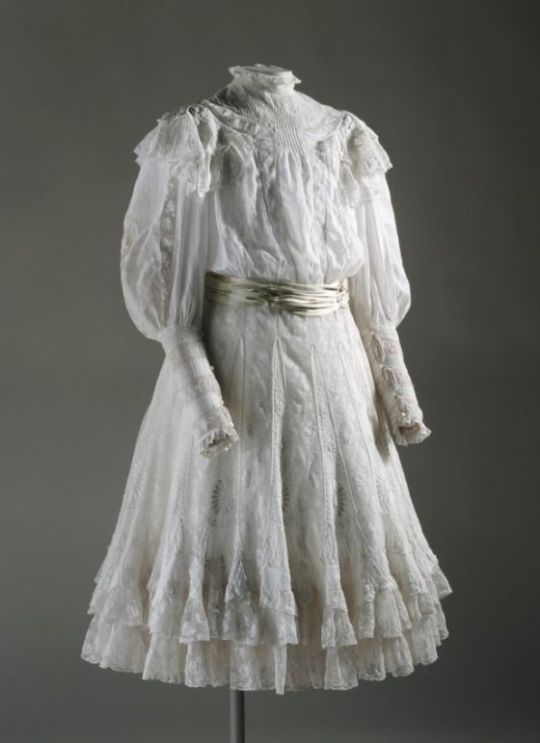

I hope that this post answered at least some of your questions about what the Tucks and Winnie Foster would have worn. If you have more questions about what Winnie would have worn as she got older, I recommend starting with this post which I wrote about how Katherine Plumber from Newsies would have dressed since they’d be around the same age in the late 1890s and then let me know if you have any more questions. And if you’d like for me to write about the fashion in a different decade that the Tucks lived through, feel free to send me another ask specifying what you’d like to know about! (I’m realizing that writing historical posts about immortal characters is more difficult than I thought it would be). Again, thank you for your question!
Sources:
https://www.youtube.com/watch?v=f9KLLbHyc4U
https://en.wikipedia.org/wiki/1795%E2%80%931820_in_Western_fashion
#ask#anonymous#tuck everlasting#jesse tuck#miles tuck#angus tuck#mae tuck#winnie foster#history#historical fashion#1800s#1890s
29 notes
·
View notes